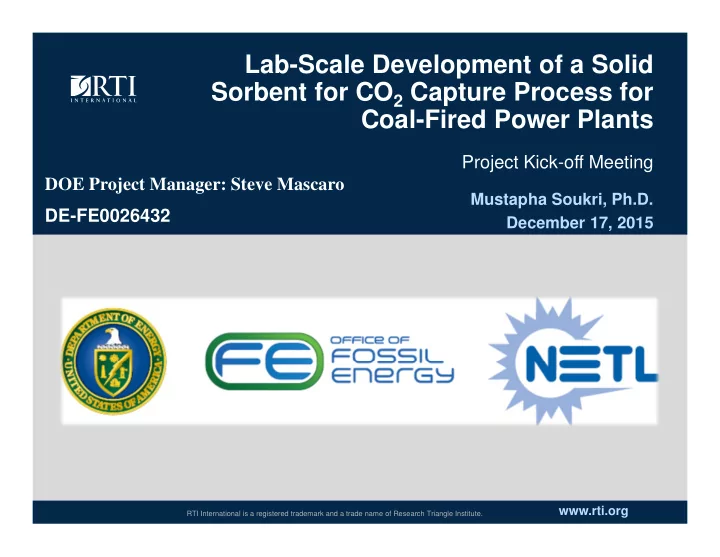

Lab-Scale Development of a Solid Sorbent for CO 2 Capture Process for Coal-Fired Power Plants Project Kick-off Meeting DOE Project Manager: Steve Mascaro Mustapha Soukri, Ph.D. DE-FE0026432 December 17, 2015 www.rti.org RTI International is a registered trademark and a trade name of Research Triangle Institute.
�������������������� � RTI CO 2 Capture Program � Solid Sorbent Based CO 2 Capture � New Project – Project Scope and Objectives – Project Team & Organization – Project Structure � Budget Period 1 � Task 1. Hybrid MOF-Based CO 2 Adsorbents Task 1. Hybrid P-Dendrimer Based CO 2 Adsorbents � Task 1 & 2. Molecular Modeling � � Budget Period 2 – Project Milestones – Risk Management – Project Budget 2
RTI CO 2 Capture Program 3
������������������������������������ • �����#$������������������������������������ ������������� � �������������������� • %������������������������������������������� Water ������������������&�������� NAS • %��������'��������������������������������� ������������������� • (��������"���������� • )�������������������������� ����������������������������� • *��+,-�������������� • ,���������������������� • .��������"�������� • /������"�������� ���������������������������� • �������������������� � ������������������� • �������������������������� � ������������������ ���������������� ��������!������"������ 4
Solid Sorbent Based CO 2 Capture (Post-Combustion) 5
���������������� � ������� Advantages • Potential for reduced energy loads and lower capital and operating costs • High CO 2 loading capacity; higher utilization of CO 2 capture sites • Relatively low heat of absorption; no heat of vaporization penalty (as with aqueous amines) • Avoidance of evaporative emissions 110ºC 110ºC 110ºC • Superior reactor design for optimized gas- 70ºC 70ºC 70ºC solid heat and mass transfer and efficient operation Challenges • Heat management / temperature control • Solids handling / solids circulation control �������������������� �! �������������������� �! �������������������� �! • Physically strong / attrition-resistant sorbent 1 1�� � *��� + 1 1�� � *��� + 1 1�� � *��� + • Stability of sorbent performance "������0������������ � 1���*/ � ⇄ */ 2 "������0������������ � 1���*/ � ⇄ */ 2 "������0������������ � 1���*/ � ⇄ */ 2 1 1�� � *��� + 1 1�� � *��� + 1 1�� � *��� + ���������0������� � 1��� � */� ⇄ � � */ � ���������0������� � 1��� � */� ⇄ � � */ � ���������0������� � 1��� � */� ⇄ � � */ � ��������0������������ � 1��� 3 *� ⇄ � 2 * 1 1�� � *��� + ��������0������������ � 1��� 3 *� ⇄ � 2 * 1 1�� � *��� + ��������0������������ � 1��� 3 *� ⇄ � 2 * 1 1�� � *��� + 6
��������"���������������������� �����������#��� $����������������� Previous Work < 2011 2011-15 2016 - 18 2018-22 > 2022 ����� ���� ���������� Proof-of-Concept / Feasibility 45$�+ $�.� 6�-7 ~ 50 MW Laboratory Validation (2011 – 2013) Prototype Testing (2015) Economic analysis Prototype Testing � Favorable technology feasibility study � Operational FMBR prototype capable of 90% CO 2 capture Sorbent development � Successful scale-up of fluidized-bed sorbent � Parametric and long-term testing Process development Updated Economics � Working multi-physics, CFD model of FMBR � Favorable technical, economic, environmental � Fabrication-ready design and schedule for single- study (i.e. meets DOE targets) stage contactor Relevant Environment Validation (2013 – 2014) Process development � Fully operational bench-scale FMBR unit capable of absorption / desorption operation � Fabrication-ready design and schedule for high-fidelity, bench-scale FMBR prototype Sorbent development � Scale-up of sorbent material with confirmation of maintained properties and performance 9 8 7 6 Technology Readiness Level � � � � � 7
�������������������%����� � �������������� Develop and design CO 2 capture solid sorbent that is chemically, thermally, and physically stable over a multiple absorption/regeneration cycles and shows significant potential to meet the DOE program targets for CO 2 capture ( >90% CO 2 capture rate with 95% CO 2 purity and <30% increase in cost of electricity). • Fluidizable material Adsorption • High CO 2 loadings, high selectivity for CO 2 capacity � 12 wt% CO 2 capture • Sorbent Selectivity Costs • No PEI leaching or degradation • Thermal & oxidative stability • Low heat of adsorption Sorbent Adsorption/ • Acceptable density Heat of desorption Adsorption • Density ~ 0.6 to 1 g/cc kinetics • Acceptable attrition resistance • Low makeup rate Mechanical Chemical strength of Stability sorbent • Economically practical particles • Low cost and easy scalability 9
���&���� � �����������������������������������"� RTI 1 st Generation : Mesoporous Silica Supported Polyethylenimine (PEI) • Good CO 2 Capture • Good Selectivity • Fluidizable • Good Heat of Adsorption Wet Impregnation PEI RTI 2 nd Generation : Water-Stable Sorbent (TEOS/PEI Co-Precipitation) • Excellent CO 2 Capture • Good Selectivity Sol-gel method • Water Stable • Good Heat of Adsorption 10
�������,�����������8 �������� �������*����� ������������ �������������������������������������������� � ������������������� ����������������������������������������������������������� Norcem’s Cement Plant – Brevik, Norway RTI’s Lab-scale Sorbent Test Unit �������������������� ��������� �������� • ����������������������������������� ��!������ �������������������������"��������������� • �������������!��"�������������� ���������� ������� #$����%&'��������%&() • ��������������������������������!���������� *������� +����,������������� �������������������� 10
Recommend
More recommend